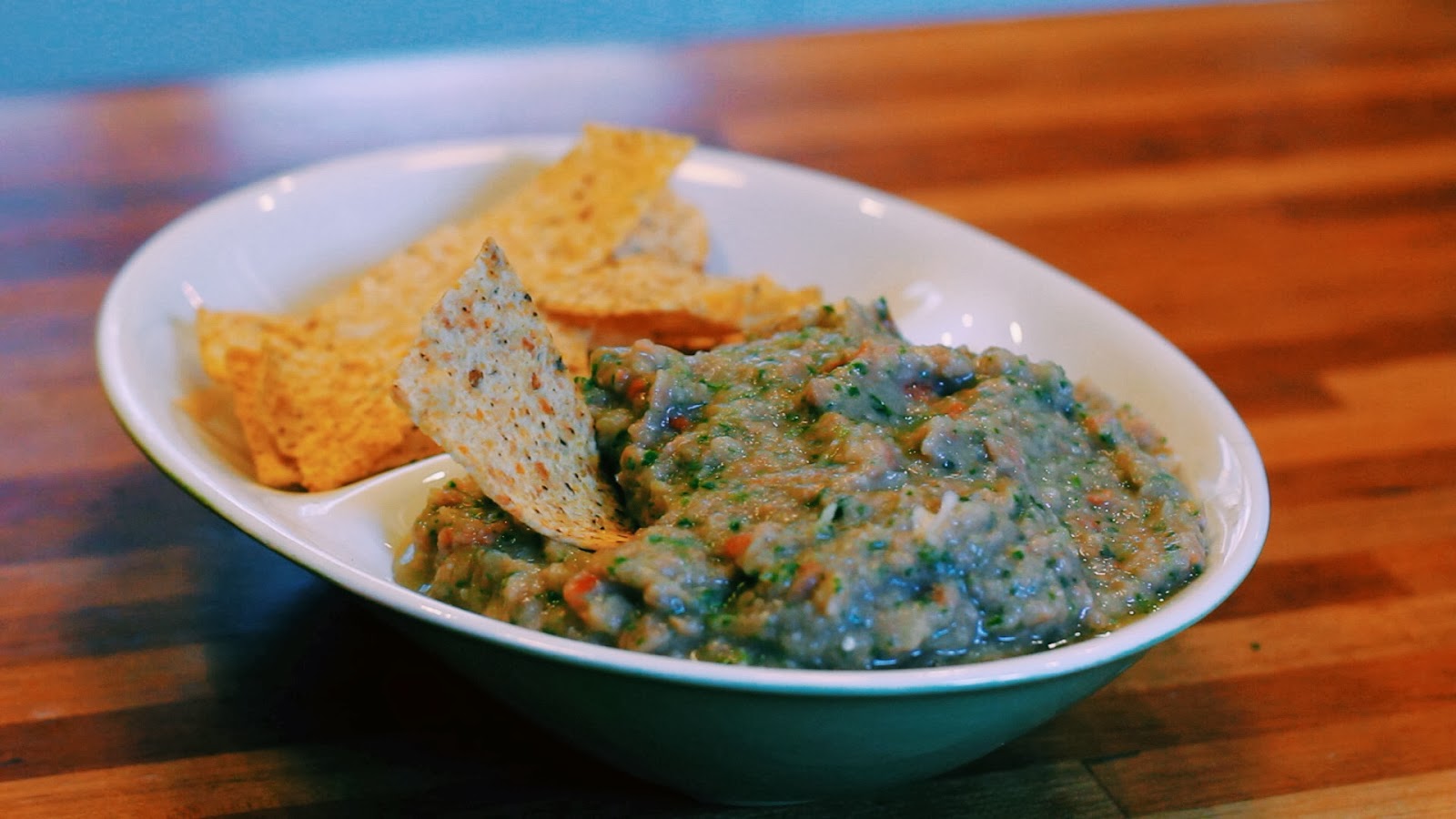The World’s Best Cornbread Recipe (not even kidding)
eHow Video: Pinto Bean Salsa Dip
eHow Video: Dry Roasted Soybeans & Some Words on Soy Myths

We all know that beans make a great dip or a great chili, but did you know they also make a great snack?
You really could us apply this recipe to any type of bean but I think soybeans are just the perfect size and, frankly, this recipe really hits the spot so I’m not too inclined to mess with it.
Many roasted bean recipes will say olive oil is necessary to get the spices to stick onto the beans, but I find they spices stick just fine if the beans are wet, so I just add the spices right after I rinse the beans. This recipe calls for 1/2 teaspoon salt, which, if you are snacking with others, is pretty moderate but you are certainly free to use less or omit it entirely if you are on a low-sodium diet.
Soybeans are incredibly nutritious. In fact, according to a recent research analysis, if Americans replaced their meat and dairy intake with soy, they would increase they intake of calcium, magnesium, iron, vitamin K, folate and fiber. But despite the plethora of scientific evidence about the health benefits of soy, there is still a lot of misinformation that continues to get passed around. I have heard some pretty extreme claims, everything from “I avoid soy because it causes dementia” to “Soy causes breast cancer” to “I don’t let my son have soy because it will turn him into a girl.” We’ve all heard claims like this, or perhaps we’ve even been the one doing the speaking. When we absorb or pass on these claims we are buying into and perpetuating a multimillion dollar anti-soy campaign sponsored by the meat and dairy industry.
So here are some important myths about soy I wanted to debunk right off the bat to put your mind at ease.
Myth: “Soy causes dementia.”
Reality: Soy does not cause dementia; in fact, it improves cognition. This myth seemed to originate from a study in which researchers found that tofu had harmful cognitive effects on people in Indonesia. However, the same was not true for tempeh, which is a more concentrated source of soy, so clearly soy itself was not the problem but something that was being added to the tofu. Well, guess what they use a preservative for tofu in Indonesia? Formaldedye! Yep, the same flammable human carcinogen that’s used to make home industrial products. So next time someone tells you soy causes dementia, set the record straight and say that formaldedye might but soy certainly does not.
More info:
http://nutritionfacts.org/video/does-tofu-cause-dementia/
Myth: “Soy causes breast cancer.”
Reality: This myth stems from the belief that soy has estrogen, and higher levels of estrogen have been linked to breast cancer. But soy doesn’t even have estrogen! It has something called phytoestrogen, but this is not estrogen. Estrogen is a sex hormone that is found in all animals (including humans). Soy, in fact, is actually protective against breast cancer. It has been shown to reduce both the recurrence of and the risk of death from breast cancer.
More info:
http://nutritionfacts.org/video/brca-breast-cancer-genes-and-soy/
http://nutritionfacts.org/video/breast-cancer-survival-and-soy/
http://nutritionfacts.org/video/soy-breast-cancer-3/
Myth: “Soy gives men “man boobs.”
Reality: Again, this probably stems from the confusion between estrogen and phytoestrogen. Soy has been shown to have no effect on a man’s testosterone levels or circulating estrogen levels whatsoever. Also, if you are concerned about getting too much estrogen from soy but are still drinking breast milk from a 1,500 lb cow, I think you are barking up the wrong tree. Cows, like humans, only produce breast milk after giving birth. The demand for dairy means that a cow is essentially always pregnant so that she will always be producing milk. So those who consume dairy are consuming the milk from pregnant cows, which have a whole lot of estrogen. In fact, people who consume meat and dairy have significantly higher levels of estrogen in their blood. Definitely check out this study which examined what happens to men’s hormone levels within in just one hour of consuming dairy (hint: their estrogen levels went up and their testosterone levels went down!).
More info:
http://www.fertstert.org/article/S0015-0282(10)00368-7
Myth: “All soy is GMO so it’s poison.” (I’ve actually heard this one verbatim.)
Reality: First of all, the largest consumer of GMO soy is farmed animals. In her article, “A Vegan Doctor Addresses Soy Myths and Misinformation”, Holly Wilson, M.D. explains that this GMO soy “does not just magically evaporate in the slaughterhouse or milk processing plant. It ends up on your plate.” Secondly, numerous brands of non-GMO tofu, tempeh, soy milk, and soy beans can be found in your grocery store labeled clearly on the package. These include Silk, Morinaga, and many others (see a comprehensive list here).
For more information debunking the misinformation about soy, read “Being Vegan and Eating Soy: Myths, Truths, and Everything In Between” by Christa Novelli M.P.H.
So please, let yourself relax about soy and enjoy this delicious and healthful snack without a worry in the world. These crunchy and crispy little beans are so much fun to pop into your mouth. Be warned: they are quite addictive!
Ingredients:
2 cans of soybeans, drained and rinsed.
1 teaspoon chili powder
1 teaspoon cumin
1/2 teaspoon salt (optional)
1/2 teaspoon allspice
1/4 teaspoon cayenne
Instructions:
1. Preheat the oven to 400 degrees. In a medium bowl, toss the spices with the soybeans until evenly coated.
2. Spread the soybeans in one layer onto a tinfoil-lined baking sheet.
3. Roast the soybeans for 45-60 minutes, stirring every 20 minutes so they cook evenly.
eHow Video: Saucy Black Bean Dip
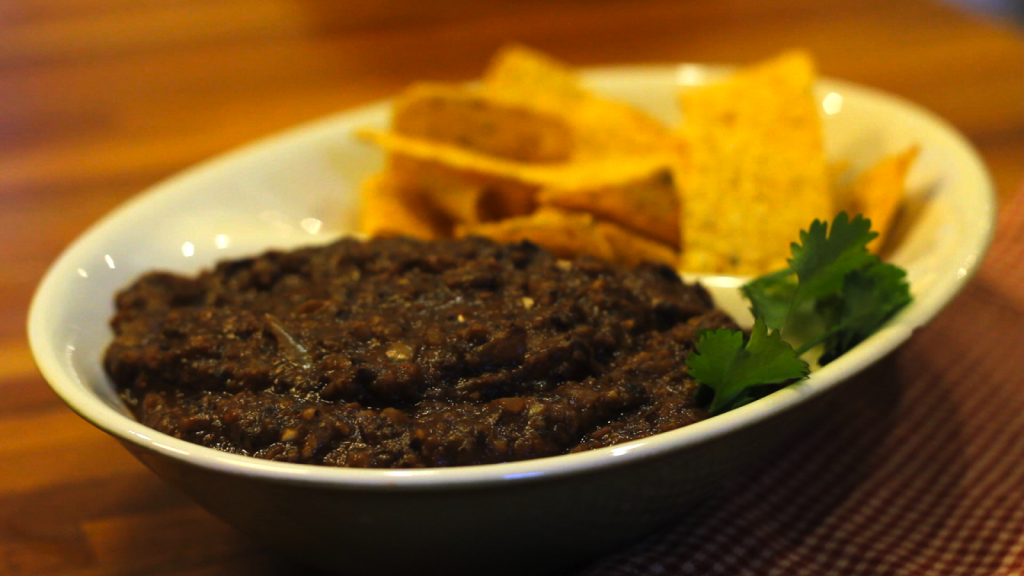

eHow Video: “Cooking Vegetable Lasagna”
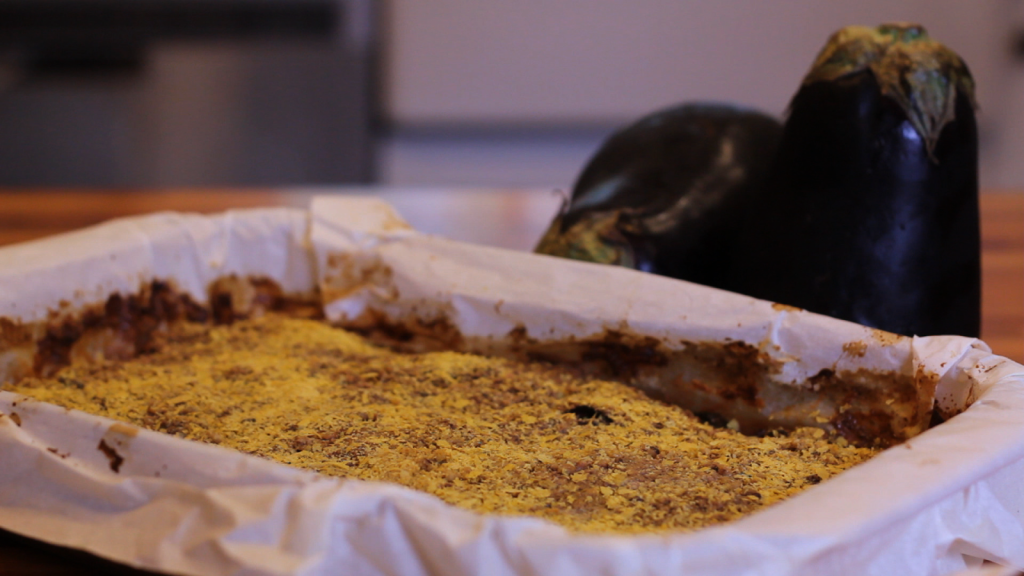
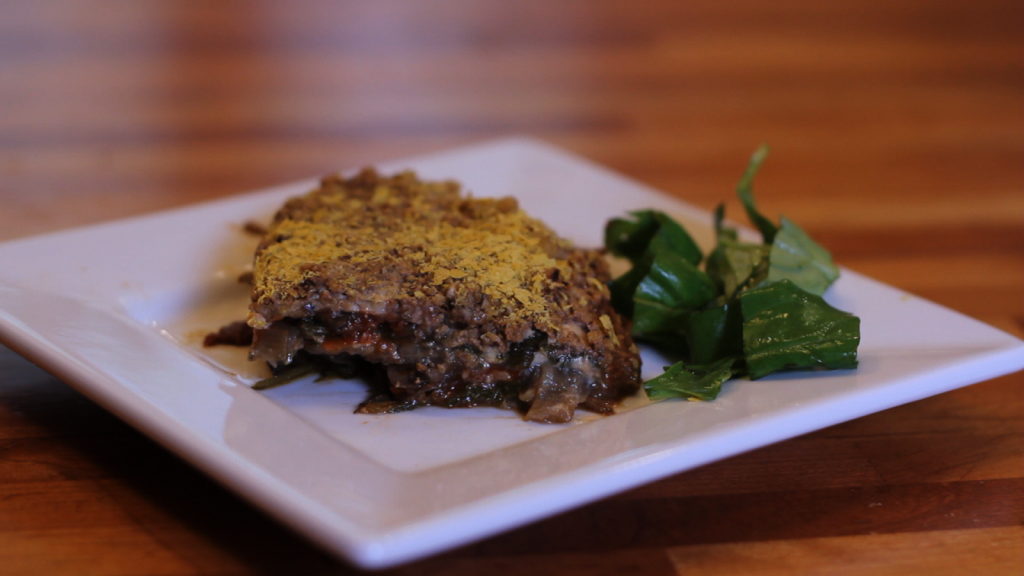
2 medium eggplants, sliced length-wise
1 bunch kale leaves (or spinach)
4 cups sliced mushrooms
1 large onion, slicedBéchemel Ingredients:
3 cups nondairy milk
1/2 cup raw cashews, soaked in warm water for at least 20 minutes
3 heaping tablespoons arrowroot flour or cornstarch
2 tablespoons lemon juice
1/4 cup nutritional yeast
1 teaspoon saltParmesan Cheese Ingredients:
1/2 cup raw walnuts
1/4 cup nutritional yeast
1/2 teaspoon salt
1. To make the béchemel sauce: Blend all the ingredients together. Add the mixture to a medium saucepan over high heat and whisk for 5-10 minutes until thickened.
2. To make the parmesan cheese: Add the ingredients to a blender and pulse until the walnuts are just ground. Be careful not to over blend into a paste.
3. Saute the onions and mushrooms for 5-7 minutes. Set aside.
4. In a large glass baking dished lined with parchment paper, layer in the following order: marinara sauce, eggplant, béchemel sauce, kale, mushrooms. Repeat until you run out.
5. Sprinkle half of the parmesan cheese on top. Bake for 1 hour covered with foil and 1 hour without foil. (I like my eggplant really soft, so feel free to lessen the time if you prefer your eggplant more chewy.)
6. Sprinkle with the remaining parmesan cheese and serve.
My eHow Video Series: Roasted Cauliflower With Mustard Butter
Because cauliflower is white, people often assume it’s a nutritional dud, on par with iceberg lettuce. But cauliflower is part of the cruciferous, or cabbage, family of vegetables. Other cruciferous vegetables include kale, bok choy, broccoli, and Brussels sprouts, which are more well-known as nutritional superstars. Cauliflower provides special nutrient support for the body’s detox system, antioxidant system, and inflammatory/anti-inflammatory system, all of which are closely connected with cancer development and cancer prevention. There are numerous studies linking diets high in cauliflower to cancer prevention, particularly breast, bladder, colon, prostate, and ovarian cancers. In addition, cauliflower contains a wide array of antioxidants, which also helps to lower cancer risk.
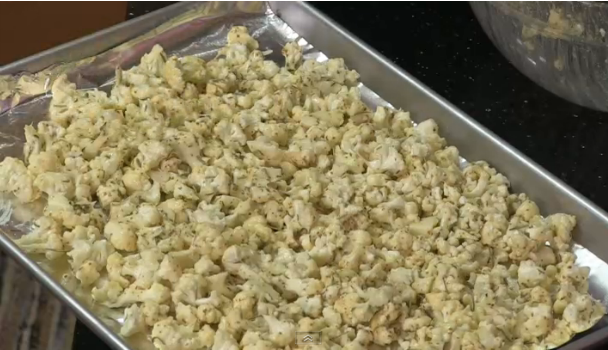
Ingredients:
1 (2 pound) head of cauliflower, cut into 1-inch florets
2 garlic cloves, chopped
1 teaspoon dried rosemary
1 teaspoon dried thyme
1 tablespoon dry white wine
2 tablespoons Dijon mustard
2 tablespoons whole-grain mustard
2 tablespoons water
Instructions:
1. Preheat the oven to 400 degrees F. Line a baking sheet with tinfoil. Set aside.
2. In a large bowl, mix sauce ingredients and stir until smooth. Add cauliflower and toss to coat.
3. Spoon the cauliflower evenly on the baking sheet.
4. Roast for 15-20 minutes until browned slightly. Transfer to a plate and serve.
My eHow Video Series: Crescent Spinach Dip
Have you ever looked up the ingredients in traditional spinach dip? You’ll find things like butter, mayo, heavy cream, and dairy cheese. It’s not really fair to call it “spinach” dip. “Saturated fat” dip would be more accurate.
The really sad thing is that none of these unhealthful ingredients are necessary for making a fantastic dip. We just include them because we always have. But just because we always have done something doesn’t mean we always have to keep doing it. We need not be slaves to custom or tradition or habit. I think most people would agree that custom, tradition, or habit aren’t good enough reasons to continue causing harm to ourselves or others, ESPECIALLY when there are quick and easy alternatives out there.
My version of spinach dip takes the spinach seriously. And, in addition to using a whole package of thawed frozen spinach, I also use a whole head of kale. Like spinach, kale is loaded with vitamins A, C, K and folic acid, and it’s also a rich source of calcium and iron. Kale also contains carotenoids, which are potent antioxidants with natural inflammatory properties that help prevent some cancers.
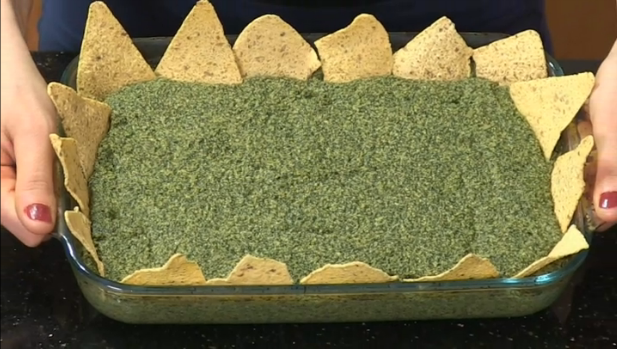
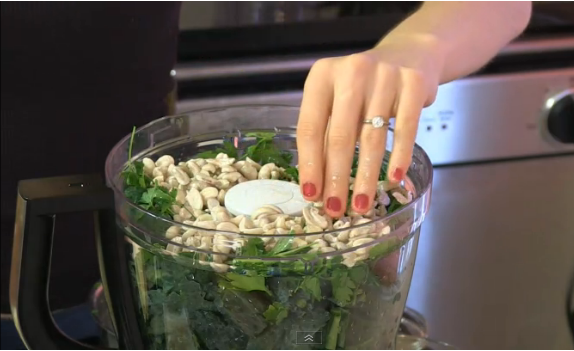
Ingredients:
16 oz. organic frozen spinach, thawed
1 bunch kale, chopped
1/2 cup raw parsley
1 cup raw cashews, soaked in warm water about 20 minutes
3 cloves of garlic
1/4 cup lemon juice
2 Tbsp apple cider vinegar
1 tsp sea salt
5 Tbsp Nutritional Yeast Flakes
1-15 oz can white beans
(optional: Daiya cheese)
Instructions:
1. Add all your ingredients (except beans and cheese) to a food processor or blender. Blend until smooth.
2. Pulse in the beans.
3. Pour spinach dip into a heat-safe serving dish. Add the Daiya cheese on top if using and place in a 350 degree oven for 15 min.
4. Serve warm with veggie sticks, bread squares and rice crackers.
My eHow Video Series: Dip for Sweet Peppers (Triple ‘S’ Dip)
This dip is a guaranteed hit at any social gathering; people just can’t seem to get enough of it! Eating it with sweet peppers is not only tasty, but also incredibly healthful since bell peppers are good for our hearts, our immune systems, our eyes, and our skin.
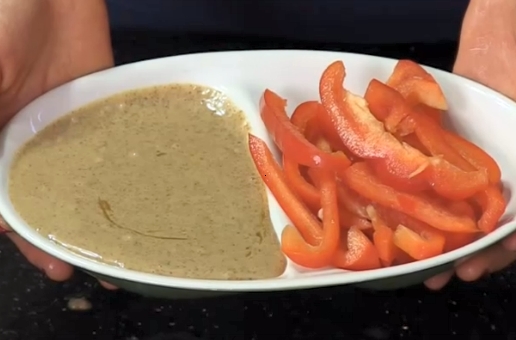
As I mention in the video, I call this dip the “Triple ‘S’ Dip” because it’s salty, spicy, and sweet. Unfortunately, the part where I add the sweetness– 2 tablespoons of maple syrup– was mistakenly cut from the video. Be sure to add that in to get the full mouthwatering trifecta of flavor.
Ingredients:
1/2 cup almond butter (or peanut butter)
3 tablespoons tahini
1/4 cup tamari (or soy sauce)
2 tablespoon maple syrup
1 tablespoon apple cider vinegar
2 cloves garlic
1 tablespoon fresh ginger
1/4 teaspoon cayenne pepper
1/3 cup water
Instructions:
1. Blend all the ingredients together and blend till smooth.
2. Serve with bell peppers.
My eHow Video Series: Tomato Puree-Based Salad Dressing
What are antioxidants and why do we want them?
Antioxidants protect your cells from the damage caused by unstable molecules called free radicals. Free radicals can lead to heart disease, cancer, cognitive decline, and other diseases, so we very much want the protection of antioxidants. Fruits and vegetables are loaded with antioxidants which is why consuming them as often and as much as possible is one of the very best things we can do for our health.
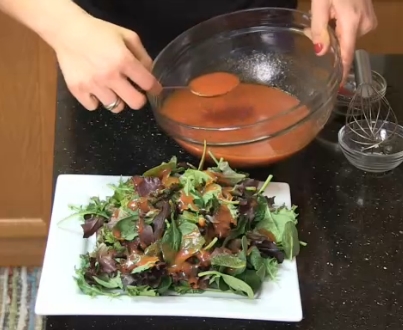
Lycopene is an antioxidant in tomatoes. In fact, it’s what gives tomatoes their red color. Scientific studies show that lycopene helps prevent lung, stomach, and prostate cancer. It also helps reduce LDL cholesterol and lowers blood pressure. In this video, I show you not only how to make a delicious salad dressing but I’ll also explain how to get the most lycopene bang for your buck. Woo hoo!
Tomato Puree-Based Salad Dressing — powered by ehow
My eHow Video Series: Sesame Eggplant Dip Recipe
In this video, I demonstrate my recipe for baba ghanouj, a Middle Eastern dish made with roasted eggplant and tahini. I am a huge eggplant fan, so baba ghanouj is naturally one of my favorite dishes in the world. If you like the flavor of hummus, you’ll most likely love baba ghanouj. It’s basically hummus’s more exotic and dramatic big sister. Like hummus, there’s lots of garlic, creaminess from tahini (sesame paste), earthy spices, and usually lots of olive oil.

In my recipe, I omit the olive oil and rely on the tahini alone to provide the fat and butteriness, and you’ll see it does the job just fine. I also leave the skin of the eggplant on, which is not typical of most baba ghanouj recipes, unfortunately. Eggplant skin is rich in nasunin, a potent antioxidant that protects cell membranes from damage.
Ingredients:
1 large eggplants (totaling 2 lbs)
2-3 tablespoons roasted tahini (sesame paste)
1-2 garlic cloves, finely chopped
1 teaspoon ground cumin
2 ½ tablespoons lemon juice
Salt and cayenne pepper to taste
1 tablespoons chopped parsley
Instructions:
1. Preheat oven to 400°F. Poke the eggplants in several places with a fork. Cut the eggplants in half lengthwise and place on a baking sheet, cut side down, and roast until very tender, about 35-40 minutes.
2. Remove from oven and allow to cool for 15 minutes.
3. Remove the eggplant skin and scoop flesh into a large bowl and mash well with a fork.
4. Combine the eggplant, minced garlic, tahini, garlic, cumin, lemon juice, the salt, and a pinch of cayenne. Mash well. You want the mixture to be somewhat smooth but still retaining some of the eggplant’s texture.
5. Allow the baba ghanouj to cool to room temperature, then season to taste with additional lemon juice, salt, and cayenne. If you want, swirl a little olive oil on the top. Sprinkle with fresh chopped parsley. Serve with pita bread, crackers, toast, sliced baguette, celery, or cucumber slices.


